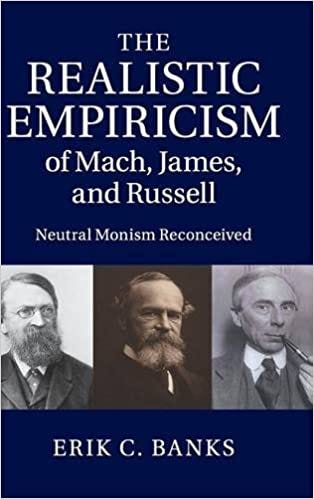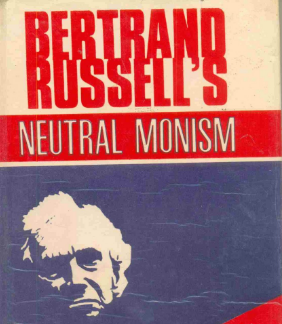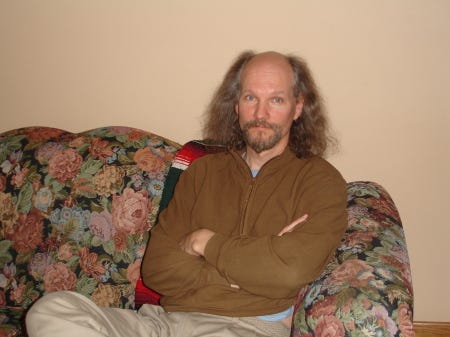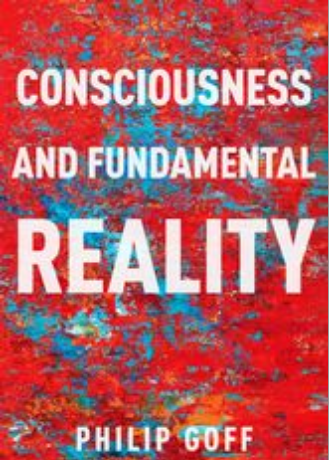The appeal of both neutral monism and panpsychism is that they appear to have the makings of two theories which are (as the philosophical jargon has it) powerful, elegant and parsimonious . In other words, they join the philosophical dots. However, it also seems to be the case that these two theories are explicitly designed to join the dots. That is, both aim to ostensibly escape from various perennial philosophical problems. (Except for the fact that monism itself has an ancient history.) But surely there must be more to these theories than all that.
So, again, both neutral monism and panpsychism seem to offer (in a manner of speaking) “elegant solutions”. The main example of this is, of course, the gap between the physical and experience (or consciousness). And an almost obvious solution to that gap is to say that both the physical and experience (consciousness) are “grounded” in the same “neutral stuff”. Now how neat is that? Not that neat, really:
1) We still need to say what this stuff is.
2) And we still need to explain the link/s between this stuff and both the physical and consciousness.
All this is compounded when we discover that what are now called “intrinsic properties” (or neutral stuff) are seen in very different ways. For example, intrinsic properties have been seen as mental; physical; mental and physical; and, of course, neutral (i.e., unknowable).
History

All this seems like a resurrection of a discussion (or debate) within Anglo-American philosophy at a particular point in history — i.e., roughly from William James in the late 1890s to Bertrand Russell in the 1920s. Of course that doesn’t mean that it’s all wrong or false. But it could mean that philosophical fashions are often resurrected when philosophers have become bored of all the contemporary alternatives on offer.
Having put that limited time scale, monism itself (perhaps even neutral monism) goes back to Baruch Spinoza. The Dutch philosopher argued that matter and mind are two “modes” (or “aspects”) of the same substance. Much later (in the late 1960s and early 1970s), just to take one other example, we also had Donald Davidson’s “anomalous monism” in the philosophy of mind. Here again the mental and physical were seen as two aspects of the same… the same what?
So it’s strange that the “weird” views of contemporary panpsychists are sometimes seen to date back to Bertrand Russell, William James and even further. Or at least they do in very specific respects.
Both James and (arguably) Russell saw their “primal stuff” as being “pure experience”. Thus experience was indeed deemed to be “all the way down” (to use a phrase usually applied to relations) by these two philosophers. (See Gregory Landini’s later contrary view on this.)
We need to note the prefix “pure” here. It hints at the fact (or possibility) that we’re not talking about an x which has experience — but pure experience itself: experience which is unchained (as it were) from things and even from stuff. To put this within context, here’s Russell quoting James:
“‘My thesis is,’ [James] says, ‘that if we start with the supposition that there is only one primal stuff or material in the world, a stuff of which everything is composed, and if we call that stuff ‘pure experience.’…”
Then Russell offers his own take on James’s words above:
“James’s view is that the raw material out of which the world is built up is not of two sorts, one matter and the other mind, but that it is arranged in different patterns by its inter-relations, and that some arrangements may be called mental, while others may be called physical.”
This is a position which fuses both relationalism (or, to use an ugly word, arrangementism) and monism at one and the same time. We have both matter and mind because the same “primal stuff” is arranged in different ways. Or, in an alternative jargon, the nature of the relations between different bits of stuff produces either mind or matter. However, it’s not clear here why that stuff should also be seen as “pure experience” — as William James saw it.
Bertrand Russell’s Neutral Monism

Firstly, Russell said that his neutral monism is a monism
“in the sense that it regards the world as composed of only one kind of stuff, namely events”.
He then tells us that “it is [a] pluralism in the sense that it admits the existence of a great multiplicity of events”.
Bertrand Russell also puts the case for neutral monism at the very same time as he puts the case for for structural realism (without using that term) when he wrote the following:
“Physics is mathematical, not because we know so much about the physical world, but because we know so little: it is only its mathematical properties that we can discover.”
So Russell’s bottom line was that we have no access — either observationally or otherwise — to the “intrinsic characteristics” of objects/entities/etc. Instead “[w]hat we know about them” is simply “their structure and their mathematical laws”. That is, all we’ve got is structure and maths all the way down. That is an admission that mathematics is used in physics because we don’t know everything (as Russell himself puts it above) that is to be known about the object, condition, event, etc. under description or scrutiny. Thus mathematical equations and numerical values are the mere bones of what it is we describe.
In addition, mathematics only deals with structures, behaviour and relations/interactions; not with intrinsic properties. Another way of putting that is to argue (as Russell more or less argued) that whatever we say in the mathematical physics, none of it leads to anything intrinsic.
As just stated, Russell’s supplied us with an important distinction between (as well as emphasis upon) intrinsic stuff and mathematical descriptions. Thus there are at least two obvious positions on these intrinsic properties:
1) Intrinsic properties are somewhat like Kantian noumena.
2) Intrinsic properties simply don’t exist at all.
It’s here that we also have two options available to us:
1) To become a kind of thing-eliminativist and say that (as ontic structural realists do) “Every thing must go.”
2) To adopt a quasi-Kantian line and say that there are noumena (or intrinsic properties); though the problem is that we don’t know anything about them.
Indeed, as with option 1), we can eliminate intrinsic properties, “substances” or noumena from our ontology entirely.
Russell himself put what can be called a Kantian stance on these issues when he wrote that all we have is what he calls the “effects of a thing-in-itself”. Thus Russell came to the conclusion that if we only have access to effects (i.e., Kant’s “phenomena”), then why not factor out the distinction between noumena (or intrinsic properties) and their effects (i.e., external properties) altogether? In other words, what’s left of noumena or intrinsic properties after all this? This question is scientifically elaborated upon when Russell tells us “[w]hat can be asserted” about these matters. He writes:
“When energy radiates from a center, we can describe the laws of its radiation conveniently by imagining something in the centre, which we will call an electron or a proton according to circumstances, and for certain purposes it is convenient to regard this centre as persisting, i.e. as not a single point is spacetime but a series of such points, separated from each other by time-like intervals. All this, however, is only a convenient way of describing what happens elsewhere, namely the radiation of energy away from the centre. As to what goes on in the centre itself, if anything, physics is silent.”
Nonetheless, Russell himself still had a problem with this scientific rejection of intrinsic properties. In basic terms, it simply can’t be a question of “relations all the way down”. Russell puts it this way:
“There are many possible ways of turning some things hitherto regarded as ‘real’ into mere laws concerning the other things. Obviously there must be a limit to this process, or else all the things in the world will merely be each other’s washing.”
This, then, is at odds with Lee Smolin’s “relationalism” (to take just one example). Here we are told a relationalist story as it specifically applies to particle physics. Smolin writes (in his Time Reborn):
“In the Standard Model of Particle Physics… the properties of an electron, such as its mass, which determines how much force is needed to change its motion. In the Standard Model, all the particles’ masses arise from their interactions with other particles and are determined primarily by one — the Higgs particle. No longer are there absolutely ‘elementary’ particles; everything that behaves like a particle is, to some extent, an emergent consequence of a network of interactions.”
Thus, in simple terms, particles have no “parts” (as Smolin puts it elsewhere). However, they do indeed have “properties”. These properties are all “relational” (or they’re the product of “interactions”). Mass, for example, is a relational property in that a particle’s mass is a product of its interactions with other particles — primarily with Higgs bosons.
Gregory Landini on Bertrand Russell

According to the American philosopher Gregory Landini, Russell’s neutral monism is not a version of panpsychism. That is, Landini’s Russell didn’t believe in experience all the way down. (This case is complicated because Landini uses the word “qualia” — which is certainly putting the cat among the pigeons.) Instead:
“[Q]ualia never occur in transient particulars. In Russell’s view, qualia emerge from the series of brain states…colors, pitches, smells, tastes and textures are emergent properties of series of brain states.”
In other words, qualia belong to brain states. And brain states are highly complex. Another way of putting this is to say that qualia aren’t properties of basic “transient particulars”. So this, surely, is radically at odds with panpsychism.
Again, Landini argues that Russell believed that “qualia emerge from [a] series of brain states”. Thus x also be seen as being both qualia and Russell’s neutral stuff at one and the same time? Perhaps the problem here (again) is Landini bringing in the term “qualia” in reference to Russell. Having said that, Russell wrote about
“hearing a tire burst, or smelling a rotten egg, or feeling the coldness of a frog… particular colors and sounds”.
And aren’t these all examples of archetypal qualia? (Without Russell actually using the word “qualia”.)
Landini also argues that if neutral stuff (or his “transient physical particulars or events”) were deemed by Russell to have no experiences themselves (or not actually be experience — as with David Chalmers’ panprotopsychism), then we only get to experience proper (as it were) if it’s seen as being emergent. This is how Landini puts it:
“Qualia never occur in transient particulars. In Russell’s view, qualia emerge from the series of brain states…colors, pitches, smells, tastes and textures are emergent properties of series of brain states.”
There is a problem here though. If Russell saw
“seeing a flash of lightning…hearing a tire burst, or smelling a rotten egg, or feeling the coldness of a frog…particular colors and sounds and so on are events”
as being that primitive neutral stuff, then it can be argued that these mental events don’t need to be seen as emerging from anything. Indeed if they’re seen as neutral stuff, then they can’t be seen to have emerged from anything. Yet the problem is seeing x as primitive in the first place. In addition, even if such qualia are maximally simple in and of themselves, then it’s still the case that no consciousness state as a whole is made up of a single experience (or a single quale). Thus that whole mental state (or full consciousness) can still be seen to emerge from a set (as it were) of primitive qualia.
Here again we have the difficulty of emergence versus the primitivity (or “fundamentality”) of qualia.
If qualia (or Russell’s “percepts”) are primitive, then they can’t arise from brain states or indeed from anything else. This also seems to mean that this stuff is immediately available to us. So in what sense is it neutral when it’s also mental through and through? In that sense Russell’s neutral monism does indeed seem to square with panpsychism — despite Landini’s claims to the contrary.
The Given: Consciousness

One of the main points which unites contemporary panpsychists with Russell isn’t only the latter’s commitment to a monistic basic stuff, but also the commitment to the “fundamentality” (see Philip Goff) of consciousness/experience. (Or “percepts”, in Russell’s own case.) To all these philosophers, nothing is more (as it were) Given than experience, consciousness or percepts. Thus surely that is where we must start. Or, as David Chalmers put it, “Experience is a datum in its own right.”
I’ve just used the capitalised word “Given”. I did so because just as the Given was seen as being the basis of our epistemic knowledge (as well as for so much else), so experience (or consciousness) is seen to be the basis of ontology by panpsychists — or at least it gives panpsychists grounds for seeing its fundamental importance precisely because it is given to us. Thus panpsychists don’t move from the Given to epistemic truths or further chains of reasoning. They move from their own given to ontological conclusions about the nature of reality and mind.
In fact this link to the epistemological Given may not simply be analogical or ironic. After all, Russell himself argued that that a percept (or “quality”) isn’t something we can deduce from something else. In the jargon, it is a “primary datum”. So all this also has a foundationalist tinge to it in that Russell argued that all our knowledge of other (external) things is inferred from (or based upon) these precepts (or qualities). In other words, percepts (or experience) is the place we simply must start from.
I’ve spoken of both epistemology and ontology here. Yet this philosophical position also impacts more directly on the philosophy of mind as a whole. Thus, if we return to Russell again, it can be argued (according to Russell) that we can’t explain qualities (or percepts) in terms of the brain states that ground them if they are the primary data in the first place… Or perhaps we can… Yet it’s still the case that Russell might have also been right in arguing that the direction of the explanatory arrow must be from his percepts (or qualities) to brain states, rather than from brain states to percepts.
*****************************************
Notes
1) Bertrand Russell did seem to offer a third option: that intrinsic features are indeed emergent. In other words, we can never move from anything physical to anything mental. Or, in Russell’s own words, we
“cannot conceivably… prove that there are visual events, or auditory events, or events of any of the kind that we know by perception.”
Thus there’s no royal road from mathematical descriptions to the qualitative features of mentality because there’s always an “explanatory gap” between these two realms.
2) The move from consciousness to the physical (as well as vice versa) is found in integrated information theory.
Integrated information theorists (IIT) claim to start with consciousness and then move to the physical (or to brain states). It’s very hard, intuitively, to see how it would be at all possible to move to the postulated physical aspects (i.e., not bases or causes) of a conscious state. How would that work? How can we move, even in principle, from consciousness (or phenomenology) to the physical aspects of that consciousness state? If there’s a ontological/explanatory gap between the physical and the mental; then there may be (or is) an ontological gap/explanatory gap between consciousness and the physical. (There will be epistemological gaps too.) So how does this IIT inversion solve any of these problems?
The trick is supposed to be pulled off by an analysis of the (structural) phenomenology of a conscious state (or experience) and then accounting for it with the parallel state of the physical system — which is the physical “aspect” of that conscious state. But what does that mean? The ontological/explanatory gap, sure enough, shows its face here just as much as it does anywhere else in the philosophy of consciousness. Isn’t this a case of comparing oranges with apples — only a whole lot more extreme?
An additional problem is to explain how the physical modes (or aspects) of a conscious state must be “constrained” by the properties of that conscious state (or vice versa?). Again, what does that actually mean? In theory it’s easy (in many cases) to find some kind of structural physical correlates of conscious states. The problem would be to make sense of those correlations.
It doesn’t immediately help, either, when IIT employs quasi-logical terms to explain and account for these different aspects (or modes) of the same thing. Can we legitimately move from the axioms of a conscious experience to the properties (named “postulates”) of the physical modes (or aspects) of that conscious experience? Here we’re meant to be dealing with the “intrinsic” properties of experience which are then tied to the properties of the physical aspects (or modes) of that experience. Moreover, every single experience is meant to have its own axiom/s.
Nonetheless, if an axiomatic premise alone doesn’t deductively entail (or even imply) its postulate, then why call it an “axiom” at all?
Tononi (2015) explains this is terms of “inference to the best explanation” (otherwise called abduction). Here, instead of a strict logical deduction from a phenomenological axiom to a physical postulate, the postulates have (merely) statistical inductive support. Tononi believes that such an abduction shows us that conscious systems have “cause-effect power over themselves”. Clearly, behavioural and neuroscientific evidence may (or will) show this to be the case.










No comments:
Post a Comment